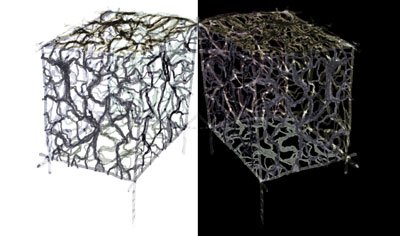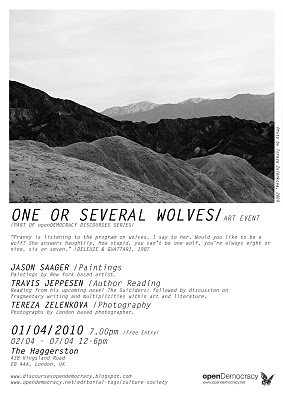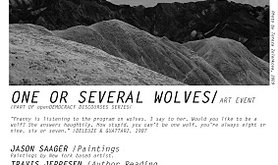"Franny is listening to the program on wolves. I say to her. Would you like to be a wolf? She answers haughtily, How Stupid, you can't be one wolf, you're always eight or nine, six or seven."
- Deleuze & Guattari, 1987
Philosophers Gilles Deleuze and Felix Guattari once claimed that we are not that far from wolves. That there are “only multiplicities of multiplicities forming a single assemblage: packs in masses and masses in packs”. To reiterate this in a slightly more decoded manner, they claim that far from being understood in the simple structural manner of a singular tree whose roots dig into the ground and whose branches extend to the sky (as theorists like Freud or Chomsky would claim), people are better understood in terms of multiplicities, in terms of a schizophrenic (as opposed to a neurotic) mind, a rhizome tree that lacks a true center, and whose branches shoot forth in all directions. People are not a simple ordering of Id, Ego and Superego desires, but rather a mess of desires and personalities which all inhabit our mind at the same time.

Broadening their thought to social theory, they assert that when people come together, form packs, we define ourselves in relation to the pack, as multiplicities within masses. A key element in Deleuze & Guattari's project of becoming-wolf, is a move to locate yourself at the periphery of the crowd, but not leaving it.
Deleuze and Guattari's philosophy can be extremely obtuse and is notoriously difficult to penetrate. Never-the-less their thought is still arguably some of the most groundbreaking philosophy of the 20th century, and as such it needs significantly more exploration as to its applicability to both art and political philosophy.
-
When most theorists and critics look at art and artists they usually fall back on the simplistic rhetoric of signs and the signifiers. Of sign, object and a singular meaning, a meaning which is often an unconscious representation of a libidinal impulse. They come so close to recognizing a multiplicity of desires, but then they always retreat back to their safe zone and lump it all together as a unified singularity representing The Unconscious. They're forgetting that the unconscious is a multiplicity, and therefore art should be examined as having not one, but several allusions working at the same time.
Artists can be viewed as a model of Deleuze and Guattari's becoming-wolf. This may be because they occupy a special position in our societies: on the periphery, yet able to move throughout the center. Their movement through the crowd enhances the multiple desires and flows of thought they engage with. But then the artist inevitably moves back to the periphery to better view the crowd and these desires are then thrown down upon canvas, scribbled onto paper or captured onto film.
The work of art may be a smooth formalist assemblage of lines and contours; a fragmentary mess of words; or a formless assemblage of colors with arcane symbols floating along side of pop cultural references. This is not to say that the artist necessarily works with the intentionality of representing Deleuze and Guattari's thought, but that regardless of the artists' presentation and intentions, each work is produced from a vantage point that allows them to view the crowd (should she or he choose to) without leaving it and becomes representational of the rhizomatic formlessness from the periphery that Deleuze and Guattari wrote about.
-
The group exhibition then becomes the perfect representation of this pack formation, not far from Jean-Luc Nancy's concept of the Inoperative Community, a temporary community brought together not because the members consider themselves as “belonging” together, but due to a shared interest. Each member (wolf) defines themselves in relation to the others, however at the same time remaining at, and working from, the periphery. The artists are solely concerned with the production of their work, their contribution; and each artist operates with a high degree of sovereignty. This is not to say that there isn't a 'leader of the pack'. Despite the sovereignty of each artist, this pack is no less hierarchical than any other group formation. However, like wolves on the hunt, in the group exhibition the organizer / curator doesn't move only in front of the but also throughout the pack - from the center to the periphery and back, exposing her or himself to the same dangers and operating with the same autonomy as the artists.
-
The first event in openDemocracy's new Discourses series, One or Several Wolves: multiplicities and packs in art, will further explore these themes by starting a dialogue with select artists as to how they engage with theory in their work.

The event features an exhibition of the photographic work of London-based photographer Tereza Zelenkova, Paintings and drawings by the New York-based artist Jason Saager and novelist and art critic Travis Jeppesen performing a reading from his upcoming novel, The Suiciders. Following the reading there will be an open discussion with the artists on their work. The event will be held on April 1st at 7pm (the reading will start promptly at 8pm) at the east London venue, the Haggerston (438 Kingsland road, E8 4AA).
The exhibition will remain open daily through April 7th from 12 – 6pm.
Read more
Get our weekly email


Comments
We encourage anyone to comment, please consult the oD commenting guidelines if you have any questions.